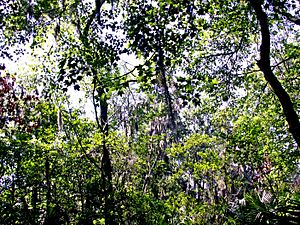Tree Hill Nature Center facts for kids
 |
|
 |
|
| Formation | 1971 |
|---|---|
| Type | Non-profit |
| Legal status | Corporation |
| Purpose | Nature preserve |
| Headquarters | 7152 Lone Star Road |
| Location | |
|
Region served
|
Jacksonville metropolitan area |
|
Executive Director
|
Mark Mummaw |
|
Main organ
|
Board of Directors |
The Tree Hill Nature Center is a special place in Jacksonville, Florida. It's a non-profit group that helps people learn about nature. It's also a wild area that protects plants and animals. The center was created to save a wild space in the city. It protects important plants and animals from buildings and roads. This city park first opened its doors in 1971. Tree Hill has also helped create other parks in Jacksonville.
Contents
About the Land
How Tree Hill Started
The original land for Tree Hill was about 40 acres. In 1975, the state of Florida bought most of this land. It was owned by a special state group called the Florida Trustees of the Internal Improvement Trust Fund. This group includes the Florida Governor and other important state leaders.
More Land for Nature
In 1998, the city bought another 10 acres for the center. This land used to be a place called Lone Star Stables. Money for this purchase came from a grant.
Work on this new land happened in three steps. The first step began in 2002. It involved cleaning up the area and building fences. They also studied the environment and made a plan for how to use the land. The city of Jacksonville gave money for this first step in 2004.
Later, more money was received to build an outdoor theater. This money also helped with planting trees, creating a parking lot, and making new trails. These trails have special learning stations along the way. Improvements like a roof for the theater and new restrooms started in 2006.
Tree Hill's Story
In early 1970, the land known as "Tree Hill" was for sale. People living in the Arlington area wanted to save it. They formed a group called the Preservation Association for Tree Hill (PATH). This group started working to buy 21½ acres of the land.
In May 1971, PATH raised $10,000. This money helped them lease the land with a chance to buy it later for $230,000. That same year, the City of Jacksonville began helping to pay for Tree Hill's operations.
A special agreement started in 1974 with the Duval County School Board. Tree Hill began teaching elementary school students about nature. They also trained teachers and created science lessons for the schools. State money, about $445,000, was given to Tree Hill in 1974. The Governor of Florida, Reubin Askew, even delivered the check himself. Soon after, the state bought the first 21.92 acres of land.
Ann Merrian became Tree Hill's first director in June 1975. A pretty gazebo-style pavilion and restrooms were finished in May 1976. An old garage on the property was turned into a Biology laboratory in November 1977.
The Environmental Center at Tree Hill opened in June 1985. Fun natural science day camps were first offered in the summer of 1986. Lucille Heine (Cortese) became Tree Hill's first paid Executive Director in 1987. She helped manage the growing number of grants and programs.
In 1990, Tree Hill received 160 acres of land on the west side of Jacksonville. This land was a gift from Martin E. Stein. Tree Hill later gave some of this land to the city. In 2000, 10 acres became McGirts Creek Park, now called Lew Brantley Park. In 2004, the rest of the land became Tillie Fowler Regional Park.
The Jacksonville Community Foundation started a special fund for Tree Hill in 2002. The Tree Hill website, www.treehill.org, also launched that year. A fun Butterfly Festival has been held every spring since 2002.
The Flight of Fancy butterfly house was built in 2007. A large outdoor theater, called an amphitheater, was also built. It can seat 300 people and has a big covered stage. The next year, the theater was named the Joseph A. Strasser Amphitheatre. This was because a donation of $150,000 was given to Tree Hill for the naming rights.
Several live animal displays were added in 2009. These included gopher tortoises, possums, goats, chickens, fish, and snakes. The nearby Jacksonville Arboretum & Gardens is also run in a similar way to Tree Hill.
What You Can See at Tree Hill
Strawberry Creek, Red Bay Branch, and Howland Creek flow through the park. The park has three different ecosystems, which are like different natural neighborhoods. It also has three walking trails. About 25,000 people visit the nature center every year.
The "hill" at Tree Hill is actually the second highest spot in Duval County. It's about 36 feet above sea level. You can also see a huge 300-year-old oak tree there!
- Animal Encounter: This is a chance to learn about local animals. You can see them up close and even touch some of them. Live animals at the center include snakes, turtles, fish, alligators, lizards, frogs, armadillos, goats, chickens, an owl, an opossum, squirrels, and raccoons.
- Guided Trail Tour: A nature expert will lead you on a tour. They will show you different animals and their homes. They will also explain how these animals survive in the wild.
- Butterfly & Hummingbird Garden: This garden is open during certain seasons. It has bright, sweet-smelling flowers that attract ruby-throated hummingbirds. The butterfly area is home to the annual Butterfly Festival. During the festival, one thousand butterflies are released. These butterflies are from 15 different species that live in Florida. Over 5,000 people come to this exciting event!
- Compost Area: Here, you can learn how compost is made. You'll see how old food and plant scraps turn into rich soil. This helps plants grow better.
- Tortoise Colony: A group of Gopher tortoises lives in a fenced area near the main building. Gopher tortoises are a threatened species in Florida. This means they are protected by state law.
Loretto Nature Center
In 1946, a man named Horace Arnold gave 11 acres of land in Mandarin to the Duval County School Board. He wanted it to be saved for the future. This land was behind Loretto Elementary School and stayed untouched for many years.
In 1990, a builder wanted to buy the land. The School Board thought about selling it. But Arnold's family and other neighbors strongly disagreed. The Mandarin Community Club started a petition to stop the sale. They wanted the land to become a nature classroom.
Experts helped create a plan for the park for free. A marine biologist from Jacksonville University studied the plants and animals. The experienced team at Tree Hill Nature Center agreed to help manage this new site. Finally, local leaders voted against selling the land.
The School Board leased the land to the city. The city then leased it to Tree Hill Nature Center. It was tricky to get to the land because of a creek and wetlands. They found the narrowest spot to cross the creek without harming important trees.
Work on the Loretto Nature Center officially began in 1993. But it took over two years to get all the permits. Construction finally started in early 1996. The trail opened on June 6 and was dedicated on July 3. A 250-foot boardwalk crosses the swamp and Oldfield Creek. Then, an asphalt path circles the property. At first, only students from Loretto Elementary could visit. But over the years, groups from other schools also started taking tours.
In October 1997, Tree Hill Nature Center received a special award. It was for their excellent work on the Loretto Nature Center. This award is given to only five projects in Florida each year.
Artists for Nature
In the summer of 2009, about 30 artists came together. This group included painters, writers, and musicians. Their goals were to help people care more about the environment. They also wanted to make more people aware of the Tree Hill Nature Center. The artists used the center to show their work. They also helped the center raise money. All of their art shows how much they love nature.
Joanelle Mulrain, an artist who works at the center, helped start this new program. The center gets a small part of the money from any artwork sold there. As part of its art program, Tree Hill also started holding concerts at the outdoor theater.
See also


